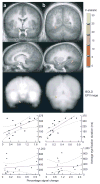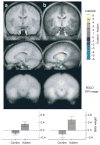Gaze fixation and the neural circuitry of face processing in autism
- PMID: 15750588
- PMCID: PMC4337787
- DOI: 10.1038/nn1421
Gaze fixation and the neural circuitry of face processing in autism
Abstract
Diminished gaze fixation is one of the core features of autism and has been proposed to be associated with abnormalities in the neural circuitry of affect. We tested this hypothesis in two separate studies using eye tracking while measuring functional brain activity during facial discrimination tasks in individuals with autism and in typically developing individuals. Activation in the fusiform gyrus and amygdala was strongly and positively correlated with the time spent fixating the eyes in the autistic group in both studies, suggesting that diminished gaze fixation may account for the fusiform hypoactivation to faces commonly reported in autism. In addition, variation in eye fixation within autistic individuals was strongly and positively associated with amygdala activation across both studies, suggesting a heightened emotional response associated with gaze fixation in autism.
Conflict of interest statement
The authors declare that they have no competing financial interests.
Figures








References
-
- Diagnostic and Statistical Manual of Mental Disorders. 4. American Psychiatric Association; Washington DC: 1994.
-
- Lord C, Cook EH, Leventhal B, Amaral DG. Autism spectrum disorders. Neuron. 2000;28:355–363. - PubMed
-
- Klin A, Jones W, Schultz RT, Volkmar FR, Cohen DJ. Visual fixation patterns during viewing of naturalistic social situations as predictors of social competence in individuals with autism. Arch Gen Psychiatry. 2002;59:809–816. - PubMed
-
- Ellis HD, Young AW. Faces in their social and biological context. In: Young AW, editor. Face and Mind. Oxford Univ. Press; London: 1998. pp. 67–95.
-
- Farah MJ, Wilson KD, Drain M, Tanaka JN. What is ‘special’ about face perception? Psychol Rev. 1998;105:482. - PubMed
Publication types
MeSH terms
Grants and funding
LinkOut - more resources
Full Text Sources

